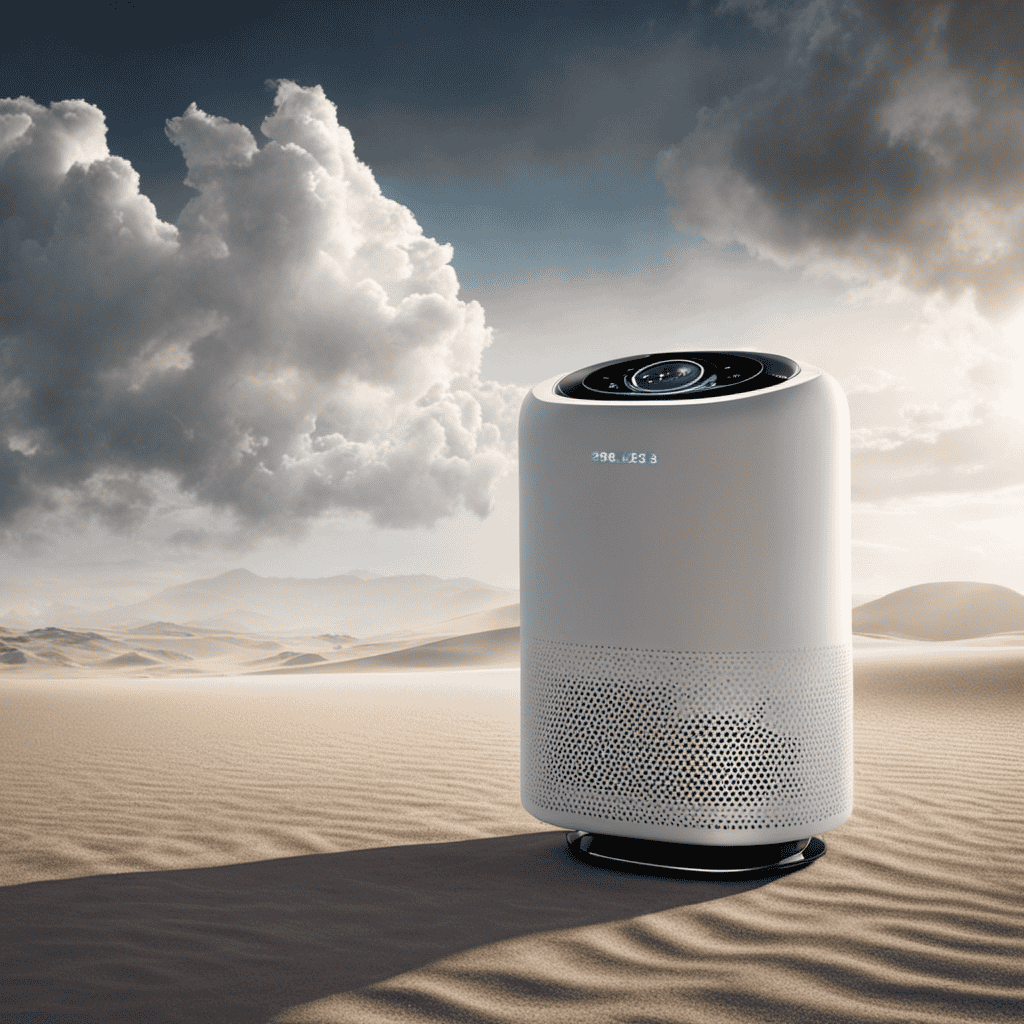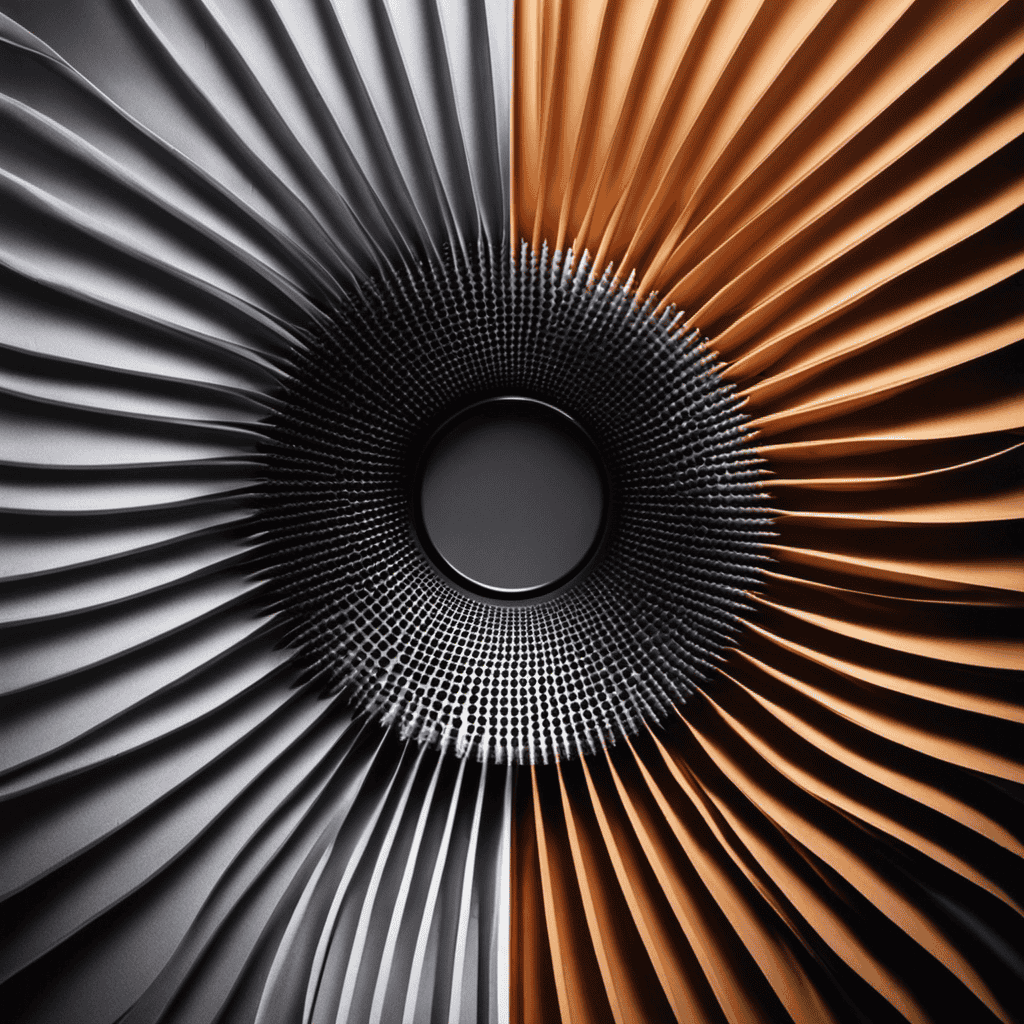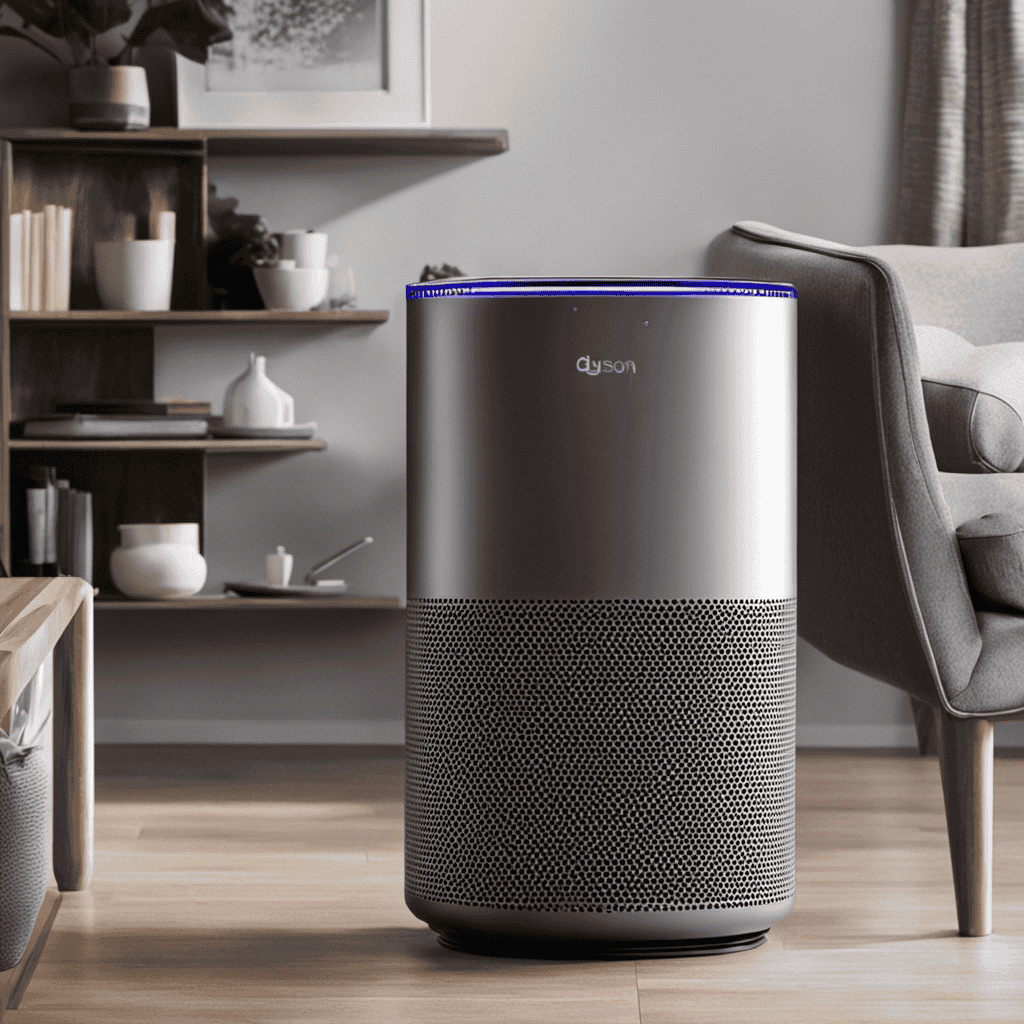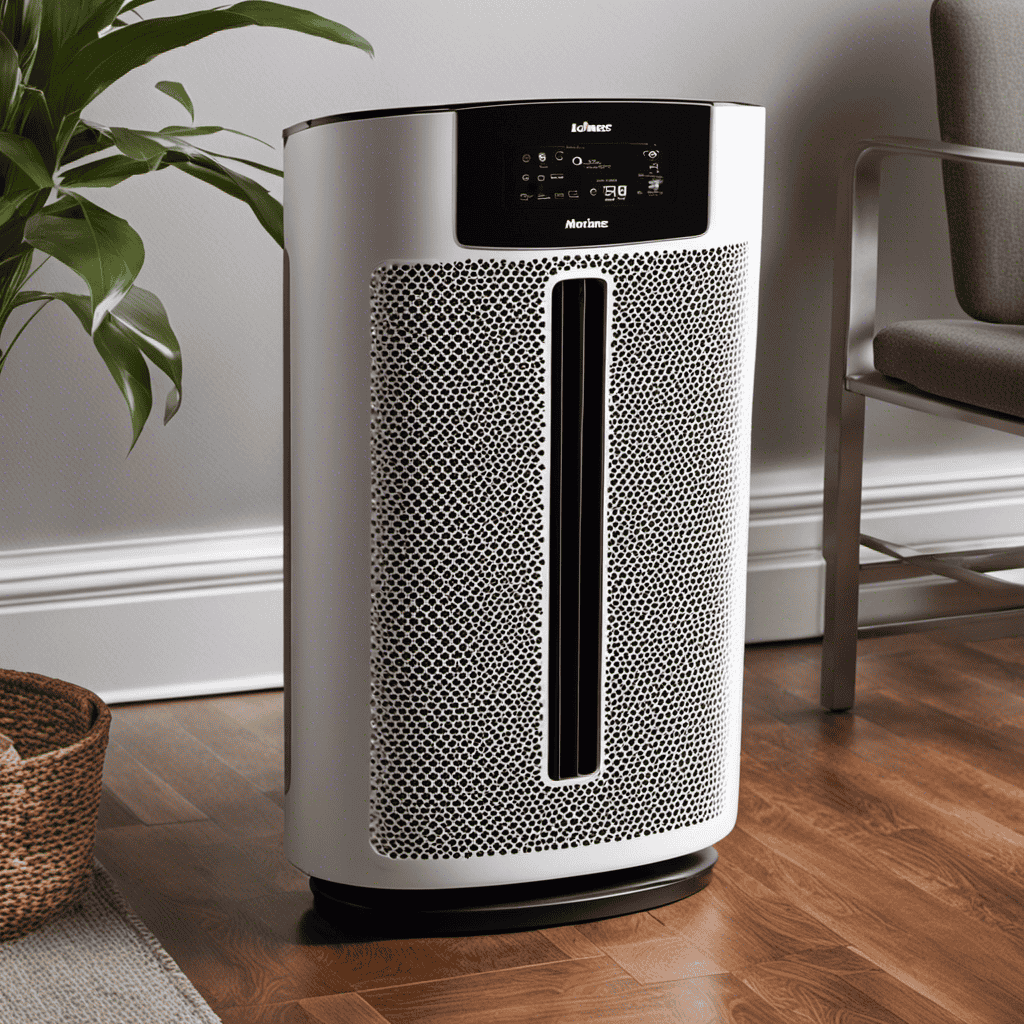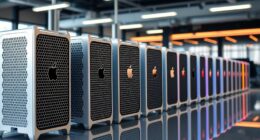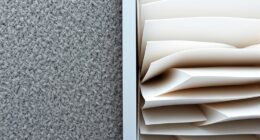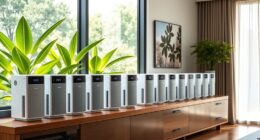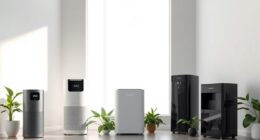Ever thought about the longevity of an air purifier? Allow me to give you all the information you need.
In this article, we will delve into the factors that affect the lifespan of an air purifier, the average lifespan of different types of air purifiers, and the signs that indicate when it’s time for a replacement.
Additionally, I will share maintenance tips to extend the lifespan, common problems that can shorten it, and even tips on upgrading to a more eco-friendly option.
So, let’s dive in and explore the fascinating world of air purifiers!
Key Takeaways
- The lifespan of an air purifier can be extended through regular filter maintenance and cleaning.
- Different types of filters have varying lifespans, with HEPA filters lasting 3 to 5 years and carbon filters lasting 6 to 12 months.
- Signs indicating the need for air purifier replacement include ineffective odor removal, strange noises, and mechanical issues.
- Following manufacturer’s instructions for cleaning and filter replacement is crucial in maintaining optimal filtration performance.
Factors That Affect the Lifespan of an Air Purifier
When you’re considering the lifespan of an air purifier, there are several factors that can affect how long it lasts. One of the most important factors is filter maintenance. Regularly cleaning or replacing the filters in your air purifier is crucial for its effectiveness and longevity. Over time, the filters can become clogged with dirt, dust, and other particles, reducing the purifier’s ability to clean the air. By maintaining the filters properly, you can ensure that your air purifier continues to work efficiently and effectively.
Another factor that affects the lifespan of an air purifier is its overall effectiveness. The effectiveness of an air purifier depends on various factors, such as the size of the room it is placed in, the level of pollution in the air, and the specific needs of the user. If an air purifier is placed in a room that is too large, it may struggle to clean the air effectively. Similarly, if the level of pollution in the air is extremely high, the purifier may have to work harder and may not last as long. It is important to choose an air purifier that is suitable for your specific needs and to regularly monitor its effectiveness to ensure it is working optimally.
Average Lifespan of Different Types of Air Purifiers
You can expect various types of air purifiers to typically last around 3 to 5 years on average. However, the lifespan of an air purifier can be influenced by several factors such as the quality of the unit, the frequency of use, and the maintenance techniques employed.
Here are some key points to consider:
-
HEPA Filters: These filters are commonly found in air purifiers and are known for their high efficiency in removing airborne particles. With proper care and regular filter replacements, HEPA filters can last up to 3 to 5 years.
-
Carbon Filters: Air purifiers equipped with carbon filters are effective in removing odors and harmful gases. These filters have a shorter lifespan, typically lasting around 6 to 12 months, depending on the level of air pollution.
-
UV-C Technology: Air purifiers incorporating ultraviolet germicidal irradiation (UVGI) technology can help neutralize viruses, bacteria, and mold spores. The lifespan of UV-C lamps used in these purifiers depends on the manufacturer’s specifications, but they generally last anywhere from 9 to 12 months.
Signs That Indicate Your Air Purifier May Need Replacement
If your air purifier is not effectively removing odors or reducing airborne particles, it may be time to consider replacing it. Air purifiers are designed to improve indoor air quality by capturing and eliminating pollutants, but over time, their performance can decline.
There are several signs that indicate your air purifier may need replacement.
Firstly, if you notice that the air purifier is no longer removing odors or reducing allergens, it could be a sign of decreased performance. This can be caused by a clogged or worn-out filter. Regularly cleaning or replacing the filters is essential for optimal performance.
Secondly, if you find that your air purifier is making strange noises or emitting an unusual smell, it could be a sign of mechanical issues. These issues can affect the overall performance of the air purifier and may require professional repair or replacement.
Lastly, if you have had your air purifier for a long time and it is no longer under warranty, it may be more cost-effective to replace it rather than investing in repairs.
Maintenance Tips to Extend the Lifespan of Your Air Purifier
When it comes to maintaining an air purifier, there are three key points to consider.
Firstly, cleaning frequency recommendations vary depending on the type of air purifier. However, as a general guideline, it is recommended to clean the filters at least once every three months to ensure optimal performance.
Secondly, filter replacement guidelines are important to follow. Different filters have different lifespans, so it is crucial to adhere to the manufacturer’s recommendations. This will help maintain the efficiency of your air purifier.
Lastly, it is crucial to avoid common maintenance mistakes. Neglecting to clean the pre-filter or using improper cleaning methods can greatly impact the efficiency and lifespan of your air purifier. It is important to take care of these aspects to ensure that your air purifier functions properly.
Overall, by considering these three points – cleaning frequency recommendations, filter replacement guidelines, and common maintenance mistakes – you can effectively maintain your air purifier and ensure its optimal performance.
Cleaning Frequency Recommendations
For optimal performance, it’s recommended to clean your air purifier every three to six months. Regular cleaning is essential to maintain the efficiency and effectiveness of your air purifier. Here are some cleaning techniques and recommended cleaning products to ensure your air purifier remains in top condition:
-
Use a soft, dry cloth to wipe down the exterior of the air purifier regularly to remove any dust or dirt buildup.
-
If your air purifier has a washable filter, follow the manufacturer’s instructions to clean it. Typically, this involves rinsing the filter under running water and allowing it to dry completely before reinstalling.
-
For non-washable filters, such as HEPA filters, replace them according to the manufacturer’s recommendations to maintain optimal filtration performance.
Filter Replacement Guidelines
Regularly replacing the filters in your air purifier is crucial for maintaining optimal filtration performance.
Filter maintenance plays a critical role in ensuring that your air purifier can effectively remove pollutants and allergens from the air.
The lifespan of a filter depends on various factors such as the type of filter, the air quality in your environment, and the usage of the air purifier.
As a general guideline, it is recommended to replace the filters every 6 to 12 months. However, it is important to check the manufacturer’s recommendations for your specific air purifier model.
Neglecting filter maintenance can result in reduced air purification efficiency and may even lead to the release of captured pollutants back into the air.
Now that we understand the importance of filter replacement, let’s explore some common maintenance mistakes to avoid.
Common Maintenance Mistakes
To ensure optimal filtration performance, make sure you avoid these common maintenance mistakes with your air purifier.
-
Neglecting to clean the pre-filter regularly: The pre-filter is responsible for capturing larger particles, such as dust and hair, before they reach the main filter. Failing to clean it can reduce the overall effectiveness of your air purifier.
-
Overlooking the importance of replacing the filters: Filters have a limited lifespan and should be replaced according to the manufacturer’s guidelines. Neglecting to do so can result in reduced air quality and strain on the purifier’s motor.
-
Ignoring the cleaning of the purifier’s exterior: While the filters are crucial, it’s also essential to clean the exterior of the air purifier. Dust and dirt can accumulate on the surface, hindering its performance and potentially damaging the device.
Common Problems That Can Shorten the Lifespan of an Air Purifier
If you don’t clean or replace the filters regularly, it can significantly shorten the lifespan of your air purifier. Proper maintenance is crucial to ensure the longevity of your device and keep it functioning at its best. Let’s discuss some common problems that can arise and how to address them.
One common issue is a dirty filter. Over time, filters can become clogged with dust, allergens, and other particles. To clean the filter, remove it from the air purifier and gently vacuum or rinse it with water. Make sure the filter is completely dry before reinstalling it. If the filter is damaged or worn out, it’s best to replace it with a new one.
Another problem you may encounter is a malfunctioning fan. This can prevent the air purifier from effectively circulating clean air throughout the room. To troubleshoot this issue, check for any debris or obstructions around the fan blades. Clear away any blockages and ensure the fan is running smoothly. If the fan still doesn’t work, it may require professional repair or replacement.
Additionally, electronic components can sometimes fail, leading to a decrease in performance or total breakdown of the air purifier. It’s important to follow the manufacturer’s instructions for maintenance and troubleshooting. If you encounter any technical issues, contact the manufacturer or a qualified technician for assistance.
Understanding the Warranty Coverage for Air Purifiers
Understanding the warranty coverage for air purifiers helps ensure that you are aware of the protection and support available for your device. Air purifiers can be a significant investment, and having a comprehensive warranty in place can provide peace of mind.
Here are some key points to consider regarding air purifier warranty coverage:
-
Standard Warranty: Most air purifiers come with a standard warranty that covers manufacturing defects and malfunctions for a certain period of time. This warranty typically lasts between 1 to 3 years, depending on the manufacturer.
-
Extended Warranties: Some manufacturers offer extended warranties that can be purchased separately. These extended warranties provide additional coverage beyond the standard warranty period. They may include benefits such as free repairs or replacements for a longer duration.
-
Coverage Limitations: It’s important to carefully read and understand the terms and conditions of the warranty. Certain components or issues may be excluded from coverage, such as filters or damage caused by improper use or negligence.
-
Customer Support: Warranty coverage often includes access to customer support services. This can be helpful in case you have any questions or need assistance with your air purifier.
-
Registering Your Warranty: To ensure that you can take advantage of the warranty coverage, it’s essential to register your air purifier with the manufacturer. This typically involves providing your purchase information and product details.
How to Properly Clean and Care for Your Air Purifier
Now that we understand the warranty coverage for air purifiers, it is important to know how to properly clean and care for your device to ensure its longevity and optimal performance. Proper storage and regular maintenance are key factors in extending the lifespan of your air purifier.
To start, always refer to the manufacturer’s instructions for specific cleaning guidelines. Most air purifiers require regular filter replacements, typically every 6 to 12 months, depending on usage and air quality. Make sure to purchase the correct replacement filters recommended by the manufacturer.
Cleaning the exterior of your air purifier is also crucial. Use a soft, dry cloth to wipe away any dust or debris that may have accumulated on the surface. Avoid using harsh chemicals or abrasive materials that could damage the device.
Additionally, it is essential to troubleshoot any issues that may arise. If you notice a decrease in air purification efficiency or unusual noises, consult the troubleshooting guide provided by the manufacturer. This guide will help you identify and resolve common problems, such as clogged filters or faulty sensors.
Upgrading Your Air Purifier: When Is It Time
As an expert in air purification systems, I can provide valuable insights on when it’s time to upgrade your air purifier.
Two key factors to consider are signs of replacement and the cost of upgrades.
Signs of replacement may include decreased efficiency, increased noise, and the inability to remove airborne particles effectively.
Additionally, it’s essential to assess the cost of upgrades, considering factors such as the lifespan of the new unit, its energy efficiency, and the potential savings in maintenance and replacement costs.
Signs of Replacement
If you notice a decrease in air quality, it’s a sign that your air purifier may need replacing. Regular maintenance is essential to keep your air purifier functioning optimally.
Here is a maintenance checklist to ensure your air purifier lasts as long as possible:
- Clean or replace the filters regularly, as recommended by the manufacturer.
- Check for any signs of damage or wear on the unit, such as cracks or loose parts.
- Keep the air purifier in a well-ventilated area to prevent overheating.
Troubleshooting guide:
- If the air purifier isn’t turning on, check the power source and make sure it’s properly connected.
- If there is a strange odor coming from the purifier, clean the filters and check for any trapped particles.
Cost of Upgrades
Regular maintenance is essential to keep your air purifier functioning optimally, and it may be worth considering the cost of upgrades for improved performance.
When it comes to air purifiers, the cost of replacement parts and filters should be factored into your decision-making process. These costs can vary depending on the brand and model of your air purifier.
Additionally, energy efficiency is an important consideration when evaluating the cost of upgrades. Upgrading to a more energy-efficient air purifier can not only save you money on your energy bills but also have a positive environmental impact. Look for air purifiers with Energy Star certification, as they meet strict guidelines for energy efficiency.
Ultimately, considering the cost of replacement parts and filters, as well as the energy efficiency of an air purifier, can help you make an informed decision when considering upgrades.
Eco-Friendly Options: Long-Lasting Air Purifiers for Sustainability
One of the best eco-friendly options for long-lasting air purifiers is the HEPA filter. These filters are designed to capture and remove particles as small as 0.3 microns, including dust, pollen, pet dander, and even some bacteria.
When it comes to sustainability, there are a few key features to consider in an air purifier:
-
Energy efficiency: Look for models that are ENERGY STAR certified, as they are designed to use less energy while still providing effective purification. This not only reduces your carbon footprint but also saves you money on your energy bills.
-
Filter replacement indicators: Some air purifiers come with built-in sensors that can detect when the filter needs to be replaced. This feature ensures that you are always getting the best air quality possible and helps to prolong the lifespan of the purifier.
-
Washable filters: Opt for air purifiers with washable filters, as they can be reused multiple times, reducing waste and saving you money in the long run.
-
Quiet operation: Choose a model that operates quietly, so it doesn’t disturb your daily activities or sleep. This also means that the purifier is using less energy to run, making it more eco-friendly.
Does the Duration of Running an Air Purifier Affect Its Lifespan?
Running an air purifier for extended periods can reduce its lifespan. To improve indoor air quality with air purifier, it’s important to follow manufacturer’s guidelines for usage. Overworking the unit can lead to premature wear and tear, affecting its effectiveness in purifying the air.
Frequently Asked Questions
Can an Air Purifier Be Repaired if It Stops Working Before Its Average Lifespan?
If an air purifier stops working before its average lifespan, it can often be repaired. However, it’s important to consider the cost of repairs compared to the price of a new unit.
Some signs that indicate an air purifier needs to be replaced include decreased efficiency, strange noises, and failure to remove odors or particles from the air.
After an air purifier reaches the end of its lifespan, it can usually be recycled to minimize environmental impact.
Are There Any Special Considerations for Using an Air Purifier in a Small Room Versus a Large Room?
When it comes to using an air purifier in different room sizes, there are some important considerations.
In a small room, the benefits of an air purifier are amplified. It can effectively remove pollutants and allergens, creating a healthier environment.
However, in a large room, the drawbacks become apparent. The air purifier may struggle to cover the entire space, resulting in less efficient air purification.
It’s crucial to choose the right size of air purifier for your specific room to maximize its effectiveness.
Can Using an Air Purifier Too Frequently or for Long Periods of Time Shorten Its Lifespan?
Using an air purifier for extended periods of time or frequently may impact its lifespan. Continuous usage can lead to increased energy consumption, potentially causing wear and tear on the device.
However, the benefits of using an air purifier in high pollution areas outweigh the potential drawbacks. It effectively removes harmful pollutants from the air, improving indoor air quality and promoting better respiratory health.
Regular maintenance and following manufacturer guidelines can help prolong the lifespan of an air purifier.
What Are the Potential Health Risks if an Air Purifier Is Used Beyond Its Recommended Lifespan?
Using an air purifier beyond its recommended lifespan can have potential side effects on your health. Prolonged exposure to an air purifier that is no longer functioning properly may result in decreased air quality and the presence of airborne pollutants in your home.
This can lead to respiratory issues, allergies, and other health concerns. It’s important to replace your air purifier when it reaches the end of its lifespan to ensure optimal air quality and avoid any negative impact on your well-being.
Are There Any Specific Factors That Can Cause an Air Purifier to Wear Out More Quickly in Certain Environments?
Factors affecting air purifier lifespan can vary depending on the environment it’s placed in. High levels of air pollution, such as smoke or chemicals, can cause the filters to clog up more quickly. Lack of regular maintenance, such as cleaning or replacing filters, can also shorten the lifespan.
To extend the lifespan of an air purifier, it’s important to follow the manufacturer’s recommended maintenance tips. This includes cleaning or replacing filters regularly to ensure optimal performance.
Conclusion
In conclusion, the lifespan of an air purifier can vary depending on several factors such as the type of purifier and how well it is maintained. On average, air purifiers can last anywhere from 5 to 10 years.
However, it is important to be aware of signs that indicate the need for replacement and to perform regular maintenance to extend the lifespan.
While some may argue that air purifiers are expensive and not worth the investment, the benefits of improved air quality and potential health benefits make them a worthwhile purchase for anyone concerned about their indoor air quality.

